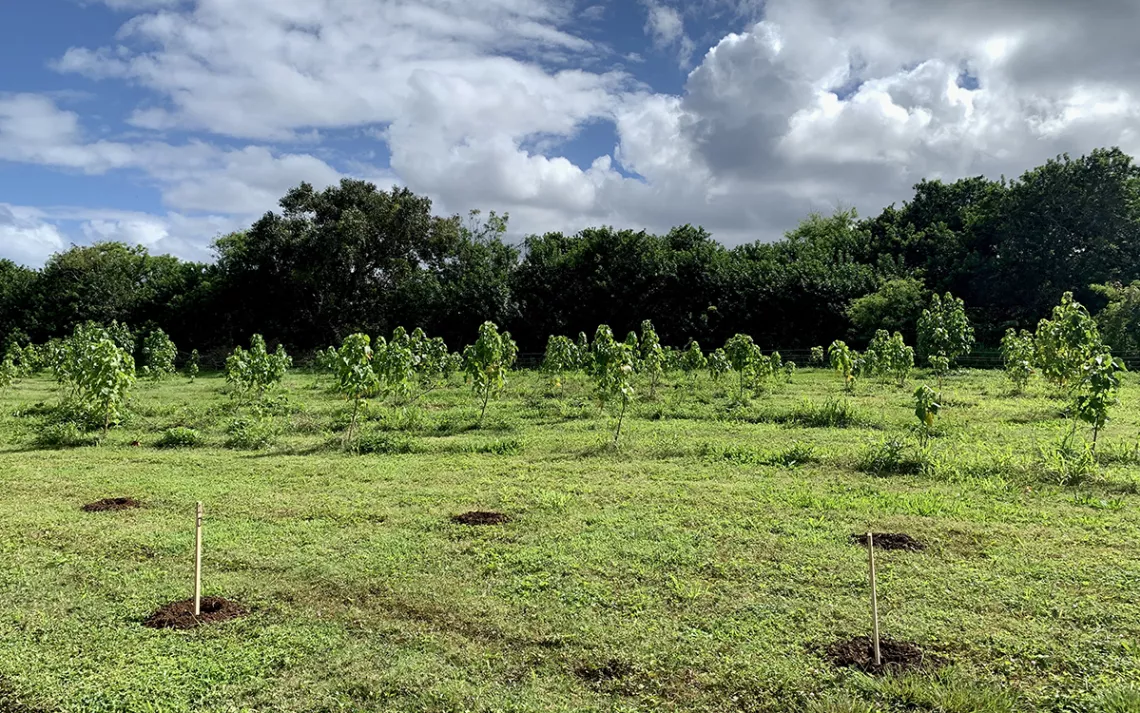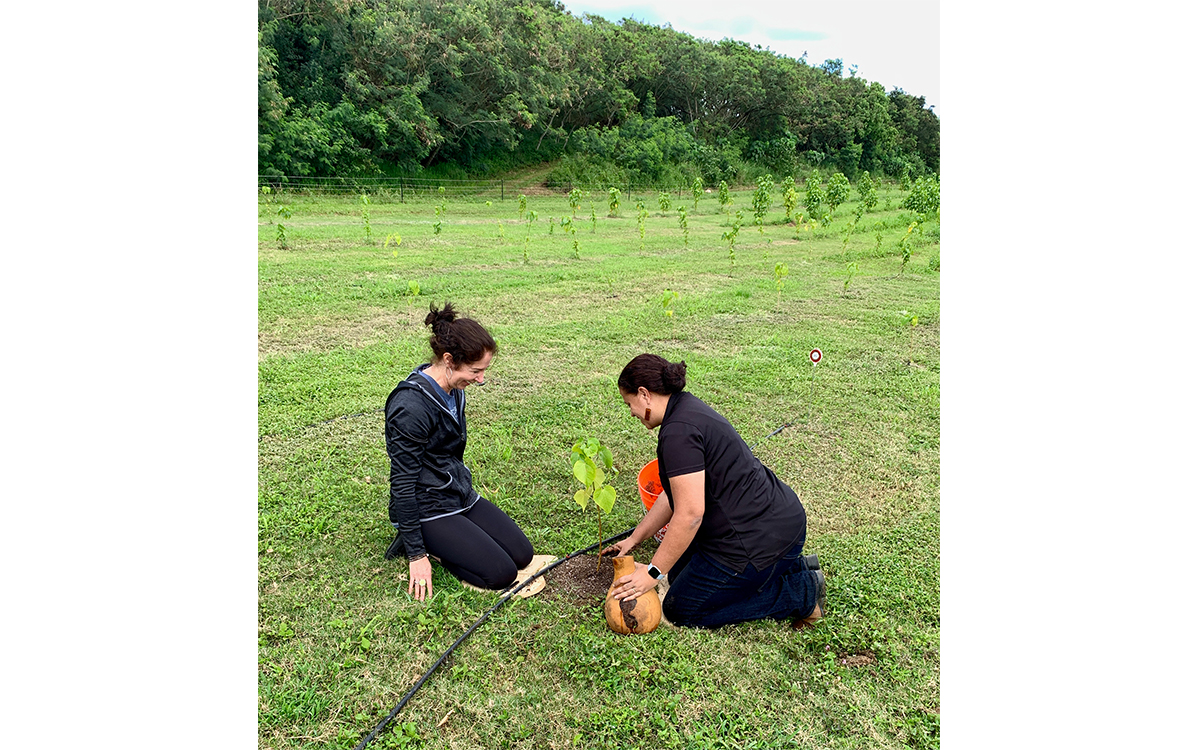Reviving Hawai'i’s Native Forests
Planting koa, milo, and ohia has a side benefit

DIY native forest | Photos courtesy of Melanie Haiken
Lilia Tollefsen, the CEO of Oahu’s Gunstock Ranch, gestures at long rows of tiny trees, their heart-shaped leaves quavering in the island breeze. “Our goal,” she says, “is to make the trees more valuable in the ground than out of it.”
Tollefsen is showing me and a small group of would-be foresters the latest project of the Hawaiian Legacy Reforestation Initiative. The saplings we’re planting are monarch milo trees, one of the original “canoe plants” brought to the islands from Polynesia by the first islanders, who used their wood to carve outrigger canoes and bowls.
Milo can grow to heights of 30 to 50 feet, with canopy spreads almost as wide, but it’s hard to picture these tiny sticks growing that big as I kneel down with mine, ready to lower it into its carefully mulched hole.
Like most of Hawai'i’s historic cattle ranches, Gunstock clearcut its forests a hundred years ago to make room for rangelands. Today the ranch is best known for its popular stables and trail rides—and now for its legacy forest, which tourists can visit as part of an eco-tour. “We’re already seeing a lot of families who want to involve their kids in something meaningful,” Tollefsen says. The 500 acres designated for reforestation are eventually slated to shelter some 600,000 native plants.
Gunstock Ranch is the third forest project for the Hawaiian Legacy Reforestation Initiative, a complex hybrid of timber investment and environmental stewardship with an ambitious goal of planting 1.3 million trees—one for every resident of Hawai'i.
The project is well on track, with 400,000 trees already planted at Kukaiau Ranch on the Big Island's Hamakua Coast. There, lush forests of king koa—a hardwood tree found nowhere else on Earth—are rising on what were, until recently, dusty plains and eroded hillsides. At a second Hawaiian ranch, Kahua in the Kohala Mountains, plans are underway to plant 700 acres of koa, ohia, sandalwood, and dozens of supporting native species.
The HLRI was founded by former investment bankers Jeff Dunster and Darrell Fox and certified as a B Corporation. Together with its business partner, Hawaiian Legacy Hardwoods, it crafts long-term lease agreements with ranchers, then plants and maintains the forests. HLRI has different arrangements for different projects, some allowing a portion of the planting to be harvested in the future. At Gunstock Ranch, however, no part of the forest will be harvested, ensuring that it will be protected for generations. The operation is very high-tech: Each tree is tagged with an ultra-high-frequency RFID tracker, which can monitor its health, and its location is noted via GPS. In 2015 the program was certified by Gold Standard, an international monitoring body, to issue carbon credits in exchange for its plantings.
Hotels and other businesses looking to up their green factor have been big supporters; in particular, Alohilani Resort and Kahala Resort on Oahu and the Four Seasons Hualalai on the Big Island have made major commitments, sponsoring swaths of native trees and promoting the initiative to their guests.
At the root of the project’s success is the skyrocketing price of koa, which—as any guitar player knows—is among the most expensive woods in the world, with top-quality mature wood selling as high as $200 a board foot. Investors are gambling on a big payback when the trees are harvested 20 to 40 years from today.
So far, the business model looks promising. “We’ve got trees that are already 60 feet tall after eight years, when it was supposed to take 10 years to get to 20 feet,” Dunster says.

Melanie Haiken planting milo sprouts with Gunstock CEO Lilia Tollefsen
When it comes to providing habitat though, koa is beyond price. The World Wildlife Fund named Hawai'i the “endangered species capital of the world”; it’s home to at least a third of all of America’s endangered species, and the loss of native koa forests has played a central role in that devastation. “Habitat is probably the biggest driver of reforestation because we’re losing so many endemic species,” says forester J.B. Friday of the Komohana Research and Extension Center at the University of Hawai'i at Manoa.
But grow it and they will come. “Just four years in, we saw baby hawks and realized we must have nesting parents,” says Dunster, his voice rising in excitement. “Then we started seeing pueo, the endemic short-eared owl, and we’ve even seen nene, the Hawaiian goose, which are incredibly rare.” Dunster’s excitement isn’t misplaced—only 800 nene remain in the wild, and the io, or Hawaiian hawk, once found throughout the islands, now remains only on the Big Island.
While impressive, HLRI’s reforestation projects are by no means Hawai'i’s largest. That honor goes to the Hakalau Forest National Wildlife Refuge, managed by the US Fish and Wildlife Service, which began its efforts back in 1989. Its giant greenhouses nurture 20,000 native species, from trees like sandalwood and ohia to delicate plants like the critically endangered haha, or Hawaiian bellflower, all grown from seeds collected, germinated, and propagated onsite.
Other reforesters include the Waikoloa Dry Forest Preserve, which has restored 275 acres of endemic dryland forest, and Hawai'i Volcanoes National Park, which is mounting an intensive effort to repel invasive plants. With a mission of forest conservation and protecting native flora and wildlife, the Hawaii Forest Institute runs a multitude of programs involving schools and community volunteers, says executive director Heather Simmons. Grants fund “discovery forests” at the Honolulu and Panaewa zoos and aid the Keauhou Bird Conservation Center in its efforts to save critically endangered birds from extinction with breed-and-release programs. “Our mission is to promote a healthy and productive forest through education and outreach and help spread the word that we need to protect the natural resources that make this such a special place,” Simmons says. The organization’s trade arm, the Hawaii Forest Institute Association, works to make native hardwoods—which are typically shipped offshore—available to local woodworkers and recently opened the islands’ first controlled island-wood market.
Another important player in the forest management landscape is Kamehameha Schools. The 130-year-old educational institution owns 364,000 acres, making it the single largest landholder in the islands. In the past 20 years, Kamehameha Schools has greatly increased its stewardship efforts and now has 138,850 acres under active conservation management.
It’s on land owned by Kamehameha Schools, during a hike up the shoulder of the volcano Hualalai, that I finally see my first native koa forest. Led by Melanie Seyler, a guide with Hawaii Forest & Trail, I gaze at the dense, primeval canopy above me and, for the first time, fully grasp what all the fuss is about. Layers of staccato cheeps, hoots, and squawks emanate from the branches above us.
“What you hear is a sound you’ve probably never heard before—the sound of a forest full of native Hawaiian birds,” says Seyler. “It can be deafening sometimes when they really get going.”
I spot numerous honeycreepers flashing bright yellow and orange among the branches. The birds’ comeback is a testament to Kamehameha Schools’ stewardship efforts, Seyler notes: “Kamehameha Schools has been so diligent in protecting this land that it's hard even to see a human footprint here.”
Asked to weigh in on the success of these reforestation efforts, the University of Hawai'i forester Friday hesitates. “We have more forests than we had 20 years ago, but most of it is eucalyptus and other weed trees,” he says. “When you look at native forests, the number of trees planted isn’t big enough to move the dial just yet.”
A stronger sign of change, though, can be seen in greatly increasing community participation in reforestation and forest conservation efforts, which is closely aligned with a resurgence of interest in traditional Hawaiian culture. “Every week of the year, somewhere on the island, there’s an event going on and people are out there planting trees,” Friday says. “The community really has a stake in this now, and that’s where I really think we’ve turned the corner.”
Dunster’s view of the future is even more optimistic. The recent plantings at Gunstock Ranch bring the total of trees in the ground to 450,000, he says, and HLRI has outstanding commitments for hundreds of thousands more. “If you can plant a tree for everyone in the state,” he says, “why not plant one for everyone in the country?”
Two weeks after I return home to the mainland, a certificate arrives in the mail with a tracking number for my very own personal monarch milo tree. I remember how I felt as I walked away from the plantation of tiny, vulnerable-looking trees. “Some local people come back and see their trees all the time, and visitors like to check up on them,” Tollefsen had told us. “They feel that sense of place and go away more conscious of the land and invested in its future.”
That’s exactly how I feel as I open the HLRI website and type in my tree’s number. And there it is, alive and flourishing.
 The Magazine of The Sierra Club
The Magazine of The Sierra Club



